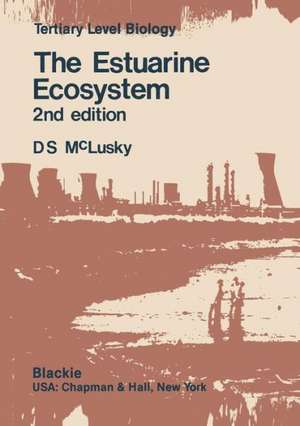The Estuarine Ecosystem: Tertiary Level Biology
Autor Donald McLuskyen Limba Engleză Paperback – sep 1989
Din seria Tertiary Level Biology
- 15%
 Preț: 637.59 lei
Preț: 637.59 lei -
 Preț: 381.00 lei
Preț: 381.00 lei -
 Preț: 382.95 lei
Preț: 382.95 lei -
 Preț: 379.86 lei
Preț: 379.86 lei -
 Preț: 381.59 lei
Preț: 381.59 lei -
 Preț: 387.20 lei
Preț: 387.20 lei -
 Preț: 362.82 lei
Preț: 362.82 lei -
 Preț: 386.99 lei
Preț: 386.99 lei -
 Preț: 382.18 lei
Preț: 382.18 lei - 15%
 Preț: 633.02 lei
Preț: 633.02 lei -
 Preț: 386.00 lei
Preț: 386.00 lei -
 Preț: 379.09 lei
Preț: 379.09 lei -
 Preț: 385.47 lei
Preț: 385.47 lei -
 Preț: 387.20 lei
Preț: 387.20 lei - 18%
 Preț: 721.01 lei
Preț: 721.01 lei -
 Preț: 387.38 lei
Preț: 387.38 lei -
 Preț: 384.48 lei
Preț: 384.48 lei -
 Preț: 382.95 lei
Preț: 382.95 lei -
 Preț: 351.90 lei
Preț: 351.90 lei -
 Preț: 381.59 lei
Preț: 381.59 lei -
 Preț: 382.36 lei
Preț: 382.36 lei -
 Preț: 380.07 lei
Preț: 380.07 lei - 15%
 Preț: 636.45 lei
Preț: 636.45 lei -
 Preț: 381.59 lei
Preț: 381.59 lei - 15%
 Preț: 660.18 lei
Preț: 660.18 lei -
 Preț: 390.84 lei
Preț: 390.84 lei -
 Preț: 384.31 lei
Preț: 384.31 lei -
 Preț: 385.62 lei
Preț: 385.62 lei -
 Preț: 384.86 lei
Preț: 384.86 lei -
 Preț: 385.08 lei
Preț: 385.08 lei -
 Preț: 378.92 lei
Preț: 378.92 lei -
 Preț: 379.48 lei
Preț: 379.48 lei -
 Preț: 384.70 lei
Preț: 384.70 lei -
 Preț: 404.67 lei
Preț: 404.67 lei -
 Preț: 381.00 lei
Preț: 381.00 lei -
 Preț: 394.71 lei
Preț: 394.71 lei -
 Preț: 376.96 lei
Preț: 376.96 lei -
 Preț: 382.18 lei
Preț: 382.18 lei -
 Preț: 379.09 lei
Preț: 379.09 lei - 15%
 Preț: 637.59 lei
Preț: 637.59 lei -
 Preț: 385.47 lei
Preț: 385.47 lei -
 Preț: 380.07 lei
Preț: 380.07 lei -
 Preț: 387.38 lei
Preț: 387.38 lei -
 Preț: 380.25 lei
Preț: 380.25 lei -
 Preț: 418.76 lei
Preț: 418.76 lei
Preț: 382.18 lei
Nou
Puncte Express: 573
Preț estimativ în valută:
73.14€ • 76.08$ • 60.38£
73.14€ • 76.08$ • 60.38£
Carte tipărită la comandă
Livrare economică 12-26 aprilie
Preluare comenzi: 021 569.72.76
Specificații
ISBN-13: 9780751401646
ISBN-10: 0751401641
Pagini: 224
Ilustrații: VIII, 216 p. 40 illus.
Dimensiuni: 148 x 210 x 12 mm
Greutate: 0.28 kg
Ediția:1989
Editura: SPRINGER NETHERLANDS
Colecția Springer
Seria Tertiary Level Biology
Locul publicării:Dordrecht, Netherlands
ISBN-10: 0751401641
Pagini: 224
Ilustrații: VIII, 216 p. 40 illus.
Dimensiuni: 148 x 210 x 12 mm
Greutate: 0.28 kg
Ediția:1989
Editura: SPRINGER NETHERLANDS
Colecția Springer
Seria Tertiary Level Biology
Locul publicării:Dordrecht, Netherlands
Public țintă
ResearchCuprins
1 The Estuarine Environment.- 1.1 Introduction.- 1.2 Estuarine circulation.- 1.3 Estuarine sediments.- 1.4 Other physico-chemical factors.- 1.5 Distribution of estuarine organisms.- 1.6 The problems of life in estuaries.- 1.7 The estuarine food web.- 2 Primary Producers: Plant production and its availability.- 2.1 Introduction.- 2.2 Salt marshes.- 2.3 Intertidal plants.- 2.4 Phytoplankton.- 2.5 Detritus.- 2.6 Summation of plant and microbial production in estuaries.- 3 Primary Consumers: Herbivores and detritivores.- 3.1 Introduction.- 3.2 The mud dwellers.- 3.3 The surface dwellers.- 3.4 Meiofauna.- 3.5 Zooplankton.- 3.6 The primary consumer community.- 4 The Secondary Consumers: Carnivores.- 4.1 Introduction.- 4.2 Fish.- 4.3 Invertebrates.- 4.4 Birds.- 4.5 The impact of the secondary consumers.- 5 Estuarine Pollution.- 5.1 Introduction.- 5.2 Mankind’s use of estuaries.- 5.3 Methodologies of studying pollution.- 5.4 Organic enrichment.- 5.5 Industrial contamination.- 5.6 Reclamation and engineering works.- 6 The Management of Estuaries.- 6.1 Introduction.- 6.2 Policies.- 6.3 Planning.- 6.4 Practice.- Reading List.





